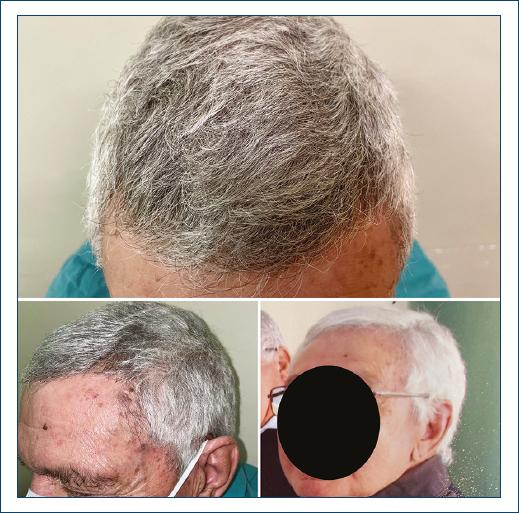Hair graying is a sign of aging that results from complex melanogenesis regulation, determined by multiple intrinsic and extrinsic factors. Treatment options for canities are currently under investigation. Drug-induced hair repigmentation is infrequently reported in the literature. Available reports document hair repigmentation following treatment with psoralen or vitamin supplementation, but also with anti-inflammatory medications (such as thalidomide, adalimumab, acitretin, prednisone, or cyclosporin), stimulators of melanogenesis (latanoprost, erlotinib, imatinib, tamoxifen, and levodopa), clofazimine, or captopril1.
A 76-year-old male was diagnosed with urticarial dermatitis, following complete clinical, analytic, and histological work-up. His chronic medication included bisoprolol, furosemide, Serenoa repens, and rosuvastatin. Treatment was initiated with a 4-week tapering course of oral prednisolone. Then, cyclosporine was introduced (3.5 mg/kg/day). Three months later, there was significant clinical response. At that same time, the patient reported hair repigmentation following several years of canities. There was no other identifiable cause, other than cyclosporine treatment, for this atypical complaint. Therapy was maintained for 9 months. Hair whitening resumed 2 months after its cessation and there was canities at 11-months follow-up.
Case reports of hair repigmentation attributed to drugs known to inhibit pro-inflammatory cytokine activity are relatively scarce and treatment duration ranges from 2 to 24 months1. To the best of our knowledge, only two other cases of hair repigmentation induced by cyclosporine have been reported2,3. The mechanism supporting this association is relatively unknown. Pro-inflammatory cytokines seem to inhibit melanogenesis and aging melanocytes may induce an inflammatory environment around the hair follicle bulb. The inhibition of these cytokines may resume melanogenesis1. Even though only a limited number of patients treated with such drugs develop hair repigmentation, these reports show that hair graying might not be an irreversible process.















